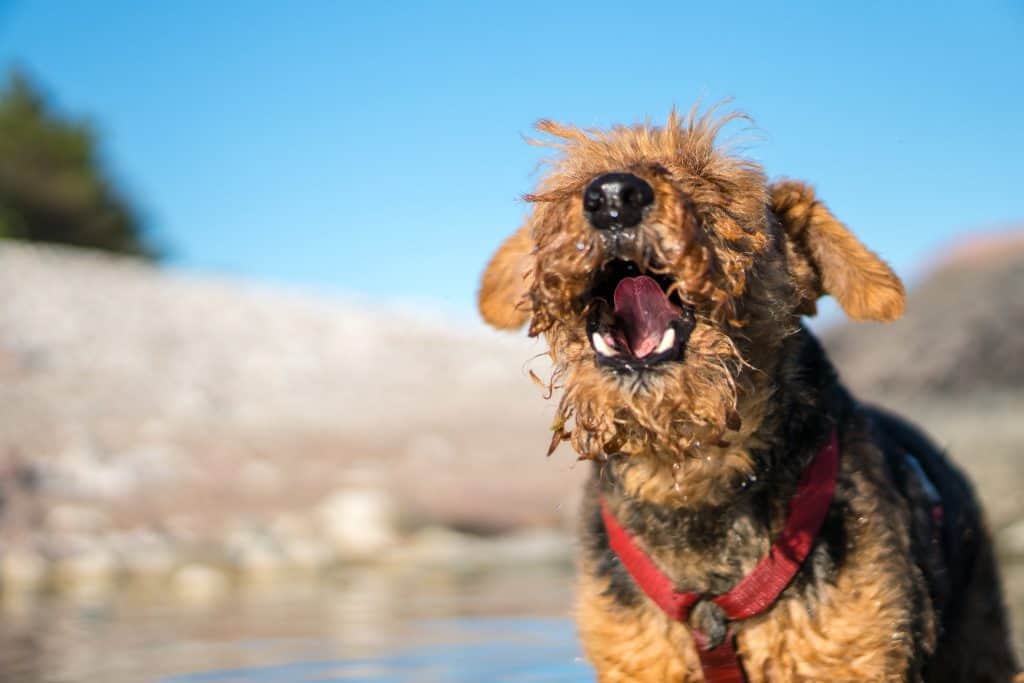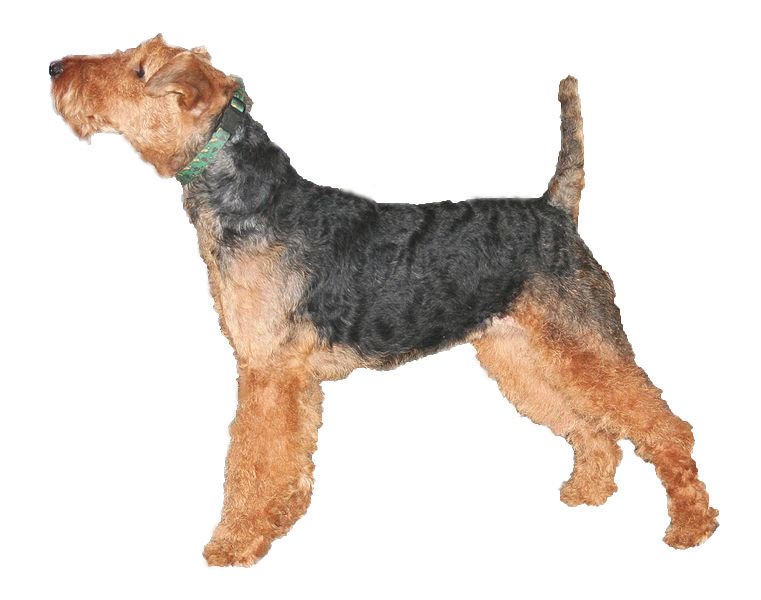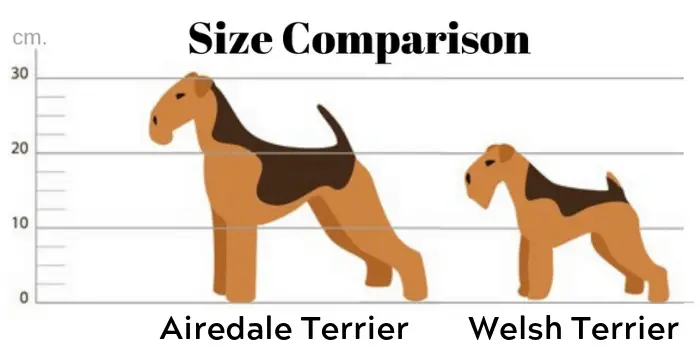Welsh Terriers are considered a rare breed of dog, with only a few hundred puppies being registered every year with the British Kennel Club
Other Names: Welshie
Country Of Origin: Wales
Dog Group: Terrier
Size: Medium
Recommended For: Families, couples, single owners
Maintenance Level: Medium
Lifespan: 12-13 years
Temperament: Confident, loyal, affectionate
FAQ:
Good For the First-Time Owner: Yes
Good With Children: Yes
Good With Other Animals: Yes
Good With Strangers: Yes
Good For Apartments: No
Exercise Requirements: Daily walking
Can Live In Hot Weather: Yes
Can Live In Cold Weather: Yes
Can Tolerate Being Left Alone: Yes
Grooming: Moderate
Trainability: Easy/moderate
Breed Overview:
The Welsh Terrier was originally bred for hunting fox and badger, but also for catching rodents.
It has a typical terrier temperament and is confident and friendly, but can also be quite stubborn.
Those that can adopt a Welsh Terrier puppy will be treated to a happy family dog.
Color: Tan head, legs, and stomach, with a black saddle
Height: 14.5-15.5 inches (both males and females)
Weight: 20-22lbs (both males and females)
Personality and Temperament:

Welsh Terriers are a friendly and energetic breed with an affectionate temperament.
Due to their role as a working dog, they need plenty of mental stimulation, and always appreciate being given something to do.
They love to play, and will never say no to a game of fetch.
While some types of Terrier can be temperamental, the Welshie’s personality makes it a great choice as a family dog.
Welsh Terrier get on really well with children and don’t need as much strict socialization as some other breeds.
However, it’s worth introducing the dog to children as early as possible to train them correctly.
Welshies are generally happy around people and are okay with strangers. However, the breed is known to bark when they feel anxious, and they’re particularly protective of their property.
You can expect a Welshie to bark in alert if it hears someone approaching the house.
The breed is of average intelligence and can pick up commands pretty quickly.
Unlike some more intelligent breeds, there’s less chance of a Welshie becoming stubborn through boredom.
However, make sure you begin obedience training from a young age and keep it up throughout the dog’s life.
When it comes to first-time owners, Welsh Terriers are a good choice because they’re low maintenance and friendly.
What’s more, Welsh Terriers are hypoallergenic, and so make the right choice for those who couldn’t normally keep a dog.
Welsh Terriers need plenty of exercises to stay fit and healthy. Ideally, they should be walked for between 30 minutes and an hour every day, along with a few games of fetch at home.
Welshies thrive on activity, so make sure you give them plenty of it. However, another reason why they’re such a good family dog is that because while they love to play, they also enjoy spending time curled up with you.
Unlike some Terrier breeds, there are generally few problems having Welshies around other dogs.
Owners should be careful around small pets like rabbits or guinea pigs though because Welshies have still got a strong prey instinct.
It’s unlikely training will ever truly get rid of this, so just be careful instead.
A Welshie with plenty of obedience training is very unlikely to attack a pet, as they’re not known as an aggressive breed, but was to catch rats, and this can still take over sometimes.
If you do own small pets, just be sure to keep an eye on the Welshie around them.
Considering Welsh Terriers can grow reasonably big, they shouldn’t be kept in apartments.
They enjoy being outside and playing whenever possible, and keeping them in an apartment could easily lead to boredom and depression.
Welsh Terriers are better suited to suburban living with at least a medium-sized backyard.
The breed is ideally suited to more moderate climates, although it can be kept in warm places.
The Welsh Terrier is one of the few breeds of dog to sweat through glands, and so they can at least regulate their temperature more effectively.
However, because of their wooly coat, Welshies will definitely get on better in colder places.
Although Welshies are a sociable breed, they can be left alone while you’re at work.
Just make sure you give them plenty of attention when you get home, and they’ll be much happier if they’ve got a friend to keep them company.
Luckily, Welsh Terriers are fine with other dogs, so don’t hesitate to keep them with other pets.
Grooming:

The only high maintenance part of keeping a Welsh Terrier is looking after their coat. Welshies have a soft, wavy coat with two layers.(image source)
There’s a warm undercoat and coarse, wiry topcoat that helps protect them from the elements.
Welshies are hypoallergenic and so don’t shed. However, you do still need to groom them.
Their coat needs hand stripping every week to remove dead hairs, and while this sounds complicated, it really isn’t.
Also, Welshies should be bathed once a month to stop their coat from smelling. The fact that they sweat means they can smell much worse than the average dog.
Welsh Terriers have floppy ears, and so these should be checked daily for debris and infection and cleaned weekly with some wet cotton wool.
Welshies should also have their coat clipped every 2-3 months in the summer, but left longer in the winter.
If you plan on bathing your Welshie regularly, make sure to use a moisturizing shampoo.
Such regular bathing would otherwise dry out their skin and lead to complications. Make sure you brush their teeth several times a week too and clip their nails whenever necessary.
Common Diseases and Conditions:
The Welsh Terrier is a generally healthy breed and has a life expectancy of 12-15 years.
The breed is prone to a condition called lens luxation, which is when a lens in the eye becomes displaced. This can lead to glaucoma in later life, and so should be treated as early as possible.
Luckily, breeders will test their stock for these conditions, and so you’d always known before you adopted your Welsh Terrier puppy.
Similarly, they use selective breeding to reduce the risk of these problems continuing.
History:
 The Welsh Terrier has long been used as a working dog and is thought to be the oldest breed of dog known in the UK.
The Welsh Terrier has long been used as a working dog and is thought to be the oldest breed of dog known in the UK.
It was in use long before the modern idea of breeds and shares many similarities with other types of Terrier.
For example, it’s often confused with the Airedale Terrier, which is a very similar dog.
When it comes to Welsh Terrier vs. Airedale Terrier, however, the Welshie is basically a more compact or “miniature” version. It’s got shorter legs and is a generally smaller dog.
The Welsh Terrier has been used for centuries as a hunting dog, primarily for fox, badger, and rats.
It would have fulfilled several roles around the home, and so made a very useful family pet.
It wasn’t registered as a breed until the late 19th century. This is mainly because it was considered a working dog, and much like the Airedale Terrier, few people saw it as anything but a working animal.
However, once it started getting shown in the ring, people began to appreciate its beauty.
One of the most notable things about Welshies is how rare they are. The United Kennel Club only receives around 300 registrations every year, and they’re in danger of dying out.
As a result of this rarity, you can expect a pretty heavy price for a Welsh Terrier. The cost could be anywhere up to $3,000 for a healthy puppy.
Despite this apparent rarity, the Welsh Terrier has a strong and loyal fan base. They often take part in shows and do well in obedience and agility.
Another issue with this rarity is that you’re unlikely to find a Welsh Terrier for sale, and will most likely have to contact a specialist breeder and be put on a long waiting list.
The Welshie was recognized by the American Kennel Club in 1888, which is very fast considering its late entry to the British books.
Although it’s just as rare in America, it similarly enjoys a strong and loyal fan base among some breeders.
Welsh Terrier Facts & Figures
Did You Know?
- President John F. Kennedy had a Welsh Terrier called Charlie.
- Similarly, Clement Atlee (British Prime Minister from 1945-1951) had a Welsh Terrier. The breed was then added into his coat of arms because he loved it so much.
- King Edward VIII, the only British king to abdicate in recent memory, had a Welsh Terrier called Gwen.
- A Welsh Terrier is featured in the animated film, Bolto III, and is called Mel. Actor David Paymer voiced the character.
- The Welsh Terrier was originally known as the Old English Terrier or the Black-and-Tan Terrier.
- The Welsh Terrier a.k.a. “Miniature Airedale Terrier” is regularly confused with the Airedale Terrier because they’re almost identical breeds, apart from their size.
You’ll find more British Dog Breeds in the links below:



